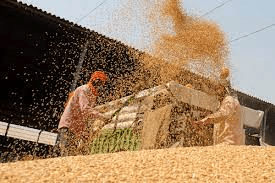Paddy, lentil, and millet MSP increases are approved by the cabinet, up to 10.35%
The government on Wednesday announced a rise in the minimum support price (MSP) for paddy of Rs 143, bringing it to Rs 2,183 per quintal for this year, the second-highest increase in the previous ten years.
The MSP for paddy increased by Rs 200 per quintal in 2018–19, which was the greatest rise in the prior ten years.

MSP has been raised for the kharif crops of 2023–2024 in the range of 5.3–10.35 percent, or by Rs 128–Rs 805 per quintal in absolute terms.
Prime Minister Narendra Modi’s Cabinet Committee on Economic Affairs (CCEA) gave its approval on Wednesday to the MSP for all mandatory kharif crops that will be cultivated in the 2023–24 crop year and purchased during the Kharif Marketing Season (October–September).
“Farmers will benefit from the increase in the MSP at a time when the retail inflation is in a declining trend,” Food Minister Piyush Goyal told the reporters after briefing them.
According to the recommendations of the CACP (Commission on Agricultural Costs and Prices), we sometimes establish MSP in agriculture. In comparison to prior years, this year’s rise in MSP for kharif crops is the largest.
For kharif grains, the MSP of “common grade” paddy has risen from Rs 2,040 per quintal in the previous year to Rs 2,183 for 2023–2024, an increase of 7% (or Rs 143). The support price for the ‘A’ grade type of paddy has increased by 143 rupees to Rs 2,203 per quintal from Rs 2,060.
The MSP for jowar (hybrid) and jowar (maldandi) has been set at Rs 3,180 and Rs 3,225 per quintal, respectively. These prices are 7% and 7.85% higher than the MSP of Rs 2,970 and Rs 2,990 in 2022–2023.
From Rs 1,962 per quintal in 2022–2023 to Rs 2,090 per quintal in 2023–2024, the MSP for maize has risen by 6.5%. From Rs 3,578 per quintal in 2022–2023 to Rs 3,846 per quintal in 2023–2023, the MSP for ragi has risen by 7.49%.
The primary kharif crop is paddy, and its seeding typically starts with the arrival of the southwest monsoon. Despite the developing El Nino conditions, the India Meteorological Department (IMD) has forecast a typical monsoon for the months of June through September.
When questioned about the double-digit inflation in cereal prices, Goyal said that it was lower than in other nations while highlighting the fact that this was due to an increase in demand for cereal as a result of rising income levels.
He said that a panel of ministers led by Home Minister Amit Shah frequently meets to assess the situation. He said that the PM has given significant attention to checking food inflation, which is considerably under control compared to other nations.
When compared to other pulses, moong had the largest rise in MSP, rising from Rs 7,755 per quintal in 2022–2023 to Rs 8,558 per quintal in 2023–2024.
The price of urad MSP climbed by 5.3% to Rs 6,950 per quintal from Rs 6,600 per quintal over the same time, while the price of tur support jumped by 6.06 percent to Rs 7,000 per quintal from Rs 6,600 per quintal.
Sesamum MSP increased by 10.28% from Rs. 7,830 per quintal in 2022–23 to Rs. 8,635 per quintal in 2023–24. Groundnut MSP increased by 9% to Rs. 6,377 per quintal from Rs. 5,850 per quintal and soyabean (yellow) MSP increased by 6.97% to Rs. 4,600 per quintal from Rs. 4,300 per quintal during the same period.
The MSP for sunflower seed has risen by 5.6% to Rs 6,760 per quintal from Rs 6,400 per quintal in 2022–23, while the MSP for niger seed has grown by 6.13 percent to Rs 7,734 per quintal in 2023–24 from Rs 7,287 per quintal in 2022–23.
Cotton (long stable) and cotton (medium stable) MSPs for cash crops have been set at Rs. 7,020 per quintal and Rs. 6,620 per quintal, respectively. These prices are 10.03% and 8.88% higher than the corresponding prices in 2022–2023 of Rs. 6,380 and Rs. 6,080.
The government announced that it has raised the MSP for Kharif crops for 2023–2024 in order to guarantee that producers would get fair prices for their goods and to promote crop diversification.
The rise in MSP is in keeping with the Union Budget 2018–19 declaration that the MSP will be set at a level of at least 1.5 times the weighted average cost of production for all of India, with the goal of providing farmers with a fairly just compensation, it added.
Bajra is anticipated to have the biggest expected margin for farmers over their cost of production (82%), followed by tur (58%) soy (52%), and urad (51%). The margin to farmers over their cost of production is predicted to be at least 50% for the remaining harvests, it said.
The government claimed that it had recently encouraged the growth of crops other than cereals by raising the MSP for such like pulses, oilseeds, and nutri-cereals.
To encourage farmers to diversify their crops, the government has also introduced a number of programmes and initiatives, including the Rashtriya Krishi Vikas Yojana (RKVY) and the National Food Security Mission (NFSM).
The output of foodgrains in the nation has significantly increased in recent years as a result of government initiatives. According to third advance projections for the crop year 2022–2023 (July–June), the nation’s total foodgrain output is predicted to reach a record 330.5 million tonnes.







